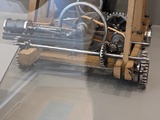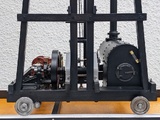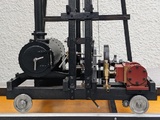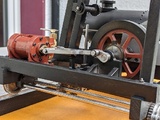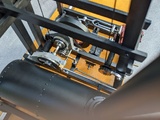A visit to Paris was at the beginning of this model. In a display cabinet of the Musée des Arts et Metiers I found Inventory No 7737. The text is basic: Machine for lifting materials by Borde. As provenance the World Exhibition Paris 1867 is given. At first I did not find more information. When I found out, that “Borde” was a proper name and Monsieur Borde had the given name “Paul”, more information showed up 1.
In 1856 the port of La Joliette in Marseille was transformed by a huge property development masterminded by the financier Jules Mirès. The engineer and builder Paul Borde was contracted to undertake this project on a very short schedule. Only mechanisation could enable the rapid and precise positioning of materials and save on scaffolding. To achieve this, Borde invented a steam-powered crane on rails running parallel to the facade of the building under construction. Materials could be deposited anywhere on the construction by varying the angle of the crane’s pivoting boom. Only two men were required to operate the machine. The success of this project won Borde other major contracts in Marseille and then Paris. His lifting apparatus was patented and gradually improved. This scale model, bought by the Conservatoire after the Universal Exposition in 1867, is probably the final version of this machine.
The model’s scale was given here with 1:20. Finally I found, that the boom had a total length of 20 m and that the pivot was 18 m above ground 2
In 1867 Borde’s cranes most likely had some stages in developing encountered. This is proved by a contempory magazine, published 1859 3. The article does not contain technical information but one section seems worth to read:
For example it seems probable, that on the quays of our big harbours you will see steam engines run from ship to ship and from the quay to the warehouses in the near future moving the goods. It is estimated that one of these machines will handle 100 tons per day.
The docks and the harbour of Marseille are used in a different way today, but the buildings, which have been erected using Borde’s crane, still exist. See a picture of Marseilles’ Touristinformation.
In his most readable book 4 Stefan Holzer points out that although there was a remarkable follow up to Borde’s crane, these constructions did not come into general use. His reasoning is the difficult controls of the steam engine, high fuel costs and long time of firing up. Of course all this is true, but it was neglected in other settings - see e.g. the catalogues of the Appleby Brothers 5. I think that assembling and dismantling these early cranes was so dangerous and problematic, that this prevented their use. After erecting the cranes structure piece by piece, the pivot point of the boom with its 20 m length had to be brought up to 18 m. When its plug-in axle finally could be put in, all men most likely would wipe off their sweat (of fear).
I had taken quite a few photos in the museum, but in the end I had to take a step back from them to get a working model. The 1867 model has some missing parts, others most likely have been added later. I doubt that the model was a working model - I think it has been used to give potential clients something to look at.
My model is in scale 1:20. It is powered by air and has the same functions as the original crane. The load may be hoisted and lowered and the crane with the load may travel on the track along an imaginary building. The one cylinder engine may have to be started manually. A slip excenter is used to change the engine’s rotation direction. A simple brake is used to fix the load when the operator wants to change from hoisting to lowering. The tilt of the boom may be changed manually.
Occasionally I have been asked if the crane might tip over. Yes - he can. Presumably quite like the original. There is evidence, that at least smaller cranes back in the days have been clamped to the rails 6. If this has been the case here - I am afraid we will not find out more than 150 years later.
You may watch a video of my model in my YouTube-Channel. The load is a small brick. It’s weight would have been 1,3 t in 1:1.
Stand 30.05.2025
-
Eck: Traité complet des constructions en poteries et en métal. Volume 1. 1868 ↩
-
Le Magasin Pittoresque 1859 Jg. 27 S.8 ↩
-
Stefan Holzer: Gerüste und Hilfskonstruktionen im historischen Baubetrieb. Berlin 2021 ↩
-
See my Warehouse Crane for more information on the Appleby Brothers. Detailed catalogues and price lists have been published since 1863. ↩
-
Appleby’s Illustrated Handbook of Machinery. Section II. Hoisting Machinery. 1877. Fig. 114 S. 22/23 ↩



